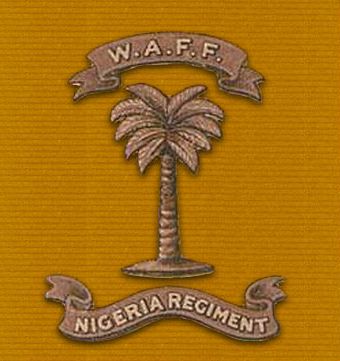
George Henry Strong

1st/4th Battalion
then
Nigeria Regiment, West Africa Frontier Force, 2nd Battalion
Lieutenant
 |  | |
| Somerset Light Infantry 1st/4th Battalion then Nigeria Regiment, West Africa Frontier Force, 2nd Battalion Lieutenant | ||
| Killed 3rd January 1917 |
George Strong's Parents | ||
|
George Henry Strong
was the eldest of four children – all boys – born to William Strong and Mary
Ann (née Exell). George’s father,
William Henry Strong, came from Devon, having been born and raised in Crediton,
the son of a farm labourer. By the age of 13, William was listed in the 1861
census in the Kiddicott are of Crediton and working as a ‘cordwainer’, which
was a term used for a shoemaker specialising in shoes from fine leather
(‘cordwain’ derived from ‘cordovan’ leather from Cordoba in Spain). At 23 (in
1871) he was still at home with his parents in Crediton, still making shoes.
Ten years later, however, he was listed as a lodger at 3 Hanover Place in Bath.
It is not known what brought him to Bath. | ||
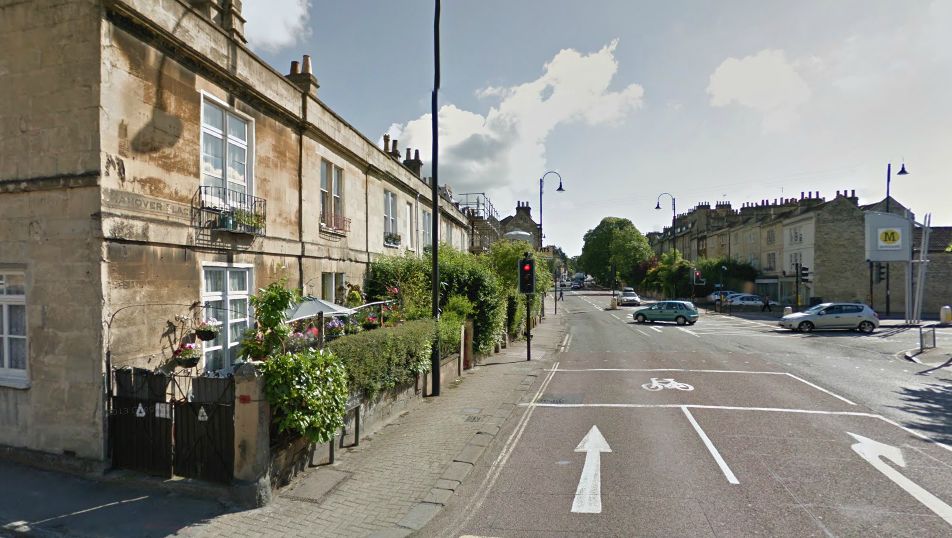 | ||
|
Hanover Place, opposite Morrisons on London Road, where George’s father William lived in his early days in Bath |
|
George’s mother was Mary Ann Exell, the daughter of George
Exell who was for 40 years the ‘High Bailiff’ of Thornbury, to the north of
Bristol. It’s not certain what his duties as ‘High Bailiff’ would have been,
but they would probably have been ceremonial, similar to those of a Sheriff
today, but for a smaller area. Mary Exell was in service in Thornbury by the age of 15
(1871 census) in the household of a widow called Catherine Lloyd, a landowner
originally from London. Ten years later, Mary Ann was still a servant but was
by now at 14 Camden Crescent in Bath. A large family appears to have been
living in the main part of the house, but Mary Ann’s employer, a widow called
Georgina Albanie, also had an apartment at that address and Mary Ann was her
sole servant. |
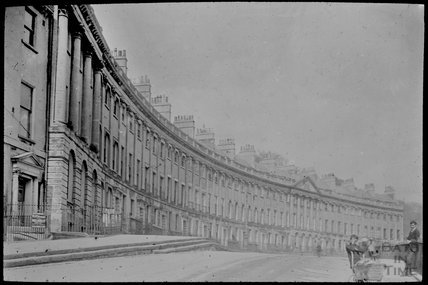 | ||
|
Camden Crescent, where George’s
mother Mary Ann was in service in the 1880s, prior to marrying William Strong
[Image: Bath In Time] |
The Strong Family |
|
William Strong and Mary Ann Exell married on the 3rd
October 1882 in Thornbury. |
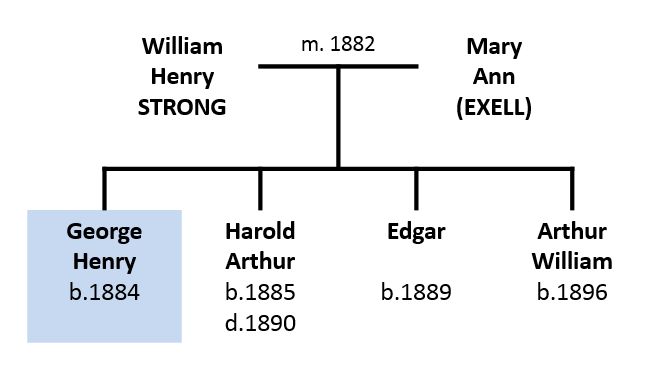 |
|
The earliest entry for the couple in the Bath Directory in 1884 shows them living at 4 Cleveland Place East, around the time that George was born. In 1886, by which time Harold had also been born, they are listed at 3 Walcot Terrace, just around the corner on the London Road. |
| In 1888 the family was listed at 1 Lower Camden Place, just to the east of Camden Crescent. |
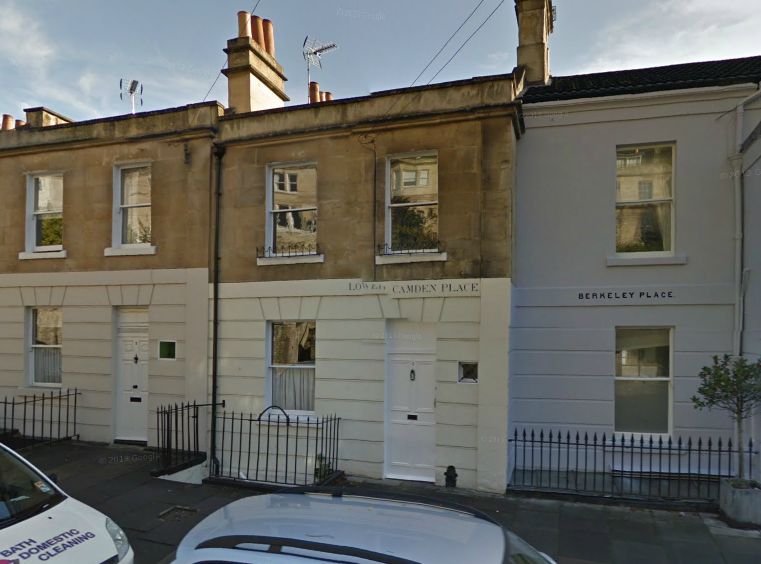 | ||
|
1 Lower Camden Place |
|
Edgar was born in 1889, soon followed by the death of the
second son, Harold Arthur, whose death was recorded in his mother’s home town
of Thornbury. In 1891, at the time of the census, the family was living at
26 Otago Terrace in Larkhall. (This was just 6 doors from the Daymond family). George was already a 'scholar', probably
attending Larkhall School (now St Saviour’s). His father’s occupation in 1891
changed from shoemaker to being an agent for sewing machines and his mother was listed as a dressmaker. By the time the last of the children came along in 1896, the
family had moved across town to Oldfield Park, bringing them into the catchment
area for South Twerton School. They lived briefly at 22 Arlington Road and then
(from 1898) at number 28. Interestingly, the Bath Directory entries at that
time listed George’s mother as head of household, with her
new occupation (‘Mrs M A Strong, nurse masseuse’) rather than his father, but
the 1901 census confirms that William Strong was still head of household, now
having returned to his trade as a shoemaker. When the family moved to Oldfield Park in 1896, George,
at age 12, would have been nearing
the end of his schooling and it is not certain that he ever attended
South Twerton School as a pupil. In 1901, (aged 17) his occupation is
listed as ‘Pupil
Teacher’, which meant he was a teacher in training. We know from
newspaper accounts that George Strong resigned from his post as
assistant master at South Twerton in August 1905. We also know from a later article in the local Bath newspaper
that George Strong studied at
Cheltenham teacher training college (and played football for the College team) before
taking up a post in Glossop, Derbyshire, where he worked from around 1906. The 1911 census shows George
living as a boarder with the Goddard family in Turnlee Road, Glossop. The
family consisted of the widowed Martha Goddard, a housekeeper, and her six
children, all between the ages of 22 and 47, all unmarried and living at home.
Their trades were centred on the Bleachworks and Paper Mills of the town. George, aged 26, was employed by the
Borough Education Committee. |
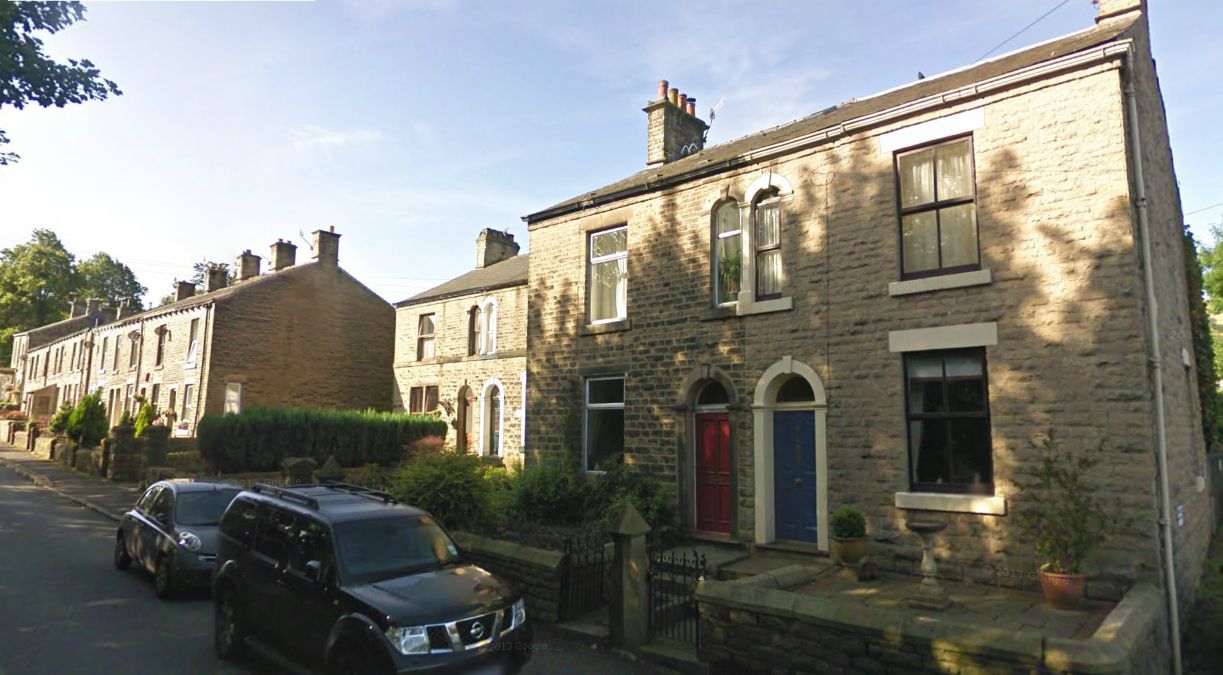 | ||
|
22 Turnlee Road, Glossop; one of the pair of houses
on the right |
|
Back in Bath, the Bath Directory entries reverted to listing Mrs M A Strong who was by now at 19 Charles Street (1903-9) and a ‘nurse masseuse and electrician’. Far from being likely to be engaged in installing electricity into houses, this would have referred to the application of some form of electrotherapy - popular at the time - as a treatment for muscle pain. In the meantime, George’s brother Edgar made the news in 1909. While working in Bristol, he sold a revolver to the rector of Luckington (near Chippenham), Rev James, who was staying with friends in Bristol while suffering from a bout of depression. Rev James used the revolver he bought from Edgar Strong to shoot himself in his hosts' bed. In 1910-11, George’s mother is listed in the Bath Directory as having moved to 39 Green Park, where the 1911 census also finds the family, still headed by William, now a boarding-house keeper (with 6 boarders also listed), and including Edgar (ironmonger’s assistant) and Arthur Strong (scholar). In 1913, George Strong returned to Bath when an opportunity arose at the school he had probably attended as a child, when the family had lived at Otago Terrace: Bath Chronicle and Weekly Gazette - Saturday 31 May 1913 ST. SAVIOUR’S BOYS’ SCHOOL THE VACANT HEADMASTERSHIP At a meeting of the managers of St. Saviour’s schools, on Wednesday, it was decided to recommend the Staffing sub-Committee of the Education Committee to appoint Mr. George Henry Strong, an assistant master, of Glossop, as headmaster of St. Saviour’s Boys’ School, in succession to the late Mr. W.H. Noad. Mr Strong, who is a Bath man, was trained at Cheltenham College and was formerly a teacher at South Twerton Council School, Bath. He has been at Glossop seven years. He took up residence in his parents’ property at Green Park. One year later, the Bath Chronicle & Weekly Gazette of 25th July 1914 carried a report of the St. Saviour’s School prize-giving and George Strong’s address as headmaster, in which he placed great emphasis on the importance of physical education and sport. That edition of the paper also carried a school group photo and a separate photo of the masters: |
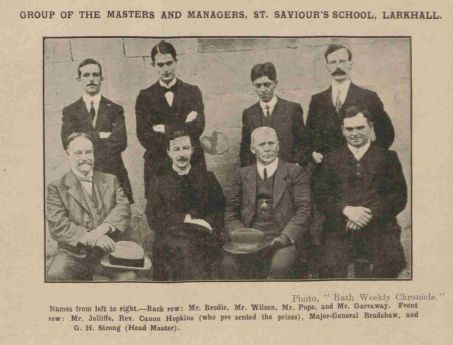 | ||
|
A photograph of the St Saviour’s schoolmasters from July 1914. George Strong is at the right-hand end of the front row. |
|
George’s
enthusiasm for sport is also reflected in his position in relation to the Bath
Schools Rugby Union at the outbreak of WW1. Bath Chronicle and Weekly Gazette - Saturday 5 September 1914 RUGBY SCHOOLS UNION. AN ADVANCED SECTION TO BE RUN. After the decision of the Bath Football Committee [this was a decision
on the part of Bath Rugby Club to suspend its fixtures in light of the ongoing
war], a meeting of the Bath Schools Rugby Union executive was held, with Mr.
George Strong presiding. It was stated that the Mayor had expressed a desire
that far from any cessation of schoolboys' football taking place, it was his
Worship's great wish that it should be extended, in order to improve the physique
of the lads and teach them pluck and endurance. It was unanimously decided to arrange the programme for 1914-15, and also to organize a Rugby section in Bath for youths between the ages of 14 and 17. A proposal was made that the Bath Club should also teach these lads drilling and rifle firing. However, it was decided that it would be undesirable to interfere with the good work of the Junior Citizens' Corps in this respect, but to encourage youths to join that body. It was further resolved that the Schools Union Committee and the Committee of the Bath Club continue for the purpose of making the Boys’ Union and the Junior Section effective. A special sub-committee was appointed to approach the Recreation Ground directors for the use of that field, and to arrange other preliminaries. Several influential citizens who had urged the abandonment of adult football, had written expressing the hope that the game for lads would be encouraged, and promising financial assistance. . |
George Strong in WW1 | ||
Somerset Light Infantry 4th Battalion
When war broke out in August 1914, George Strong joined up with the 1st/4th Somerset Light Infantry. St Saviour’s School in Larkhall have been kind enough to
look in their records for a reference to their Headmaster’s decision to enlist.
An entry in the school’s record book in September 1914 is as follows: ‘Mr G H Strong, Head Teacher, Boys Department has volunteered and had
been accepted for service in the Somerset Light Infantry during the war. ‘After due consideration it was decided that Mr F J Garraway, Assistant
Teacher, be appointed temporary Head Teacher during Mr Strong’s absence and
that one of the Assistant Teachers be transferred from the Girls Department to
the Boys’ Department pro tem.’ Samuel Edwards, Chairman The local newspaper also referenced George Strong’s
enlistment. Bath Chronicle and Weekly Gazette - Saturday 12 September 1914 MORE BATH SCHOOLMASTERS ENROLLED. Mr. George Strong, of St. Saviour's, is not the only Headmaster of a
Bath elementary school who is leaving the teaching profession temporarily to
wear the King's uniform. Mr. H. W. Vanstone, Headmaster of Bathforum, and Mr. Drew,
the recently appointed Headmaster of St. Paul's School, have also joined the
Somersets, as has also Mr. W. Gunning, Assistant Master at West Twerton. All these
gentlemen have signified their readiness to go on foreign service. The Bath Chronicle & weekly Gazette regularly posted
lists of those who had joined up, under the title “Our Citizen Soldiers”, with
listings by workplace or by some other association, such as schools. George is
listed on 3rd October 1914 under the South Twerton School heading. A
short item the following week noted that George
Strong had been replaced as Chairman on the Bath Schools Rugby Union
Committee owing to his service with the Colours. The week before, George’s youngest brother, Arthur, was
listed as having joined up to the Royal Field Artillery from among the
workforce at the Pitman Press. We also know that Edgar Strong served with the
Royal Army Medical Corps. When war broke out, the Somerset LI consisted of two regular army battalions:
There was also a Reserve (3rd) Battalion, which
was at Taunton. The 4th and 5th Battalions were
Territorial units, forming part of the South West Infantry Brigade. The 4th
Battalion had been on a training camp at Bulford Camp (near Swanage) since 26th
July, but were quickly mobilized to Plymouth. When Special Reserve Battalions
arrived in Plymouth, the 4th Battalion moved back to Salisbury
Plain, where it was joined by 5th Bn. The 4th and 5th
Battalions were then split to form the 1/4th, the 2/4th, the
1/5th and the 2/5th. India
The 1/4th and 1/5th soon sailed for
India (9th October) to replace troops of the experienced Regular
Army who were needed to fight in France. George
Strong went out with 1/4th. He had been promoted to the rank of
sergeant by the time the battalion left for India.From the 'History of the Somerset Light Infantry', by Everard Wyrall: ‘The
circumstances under which these Territorials were sent overseas when, with
every truth in the world, it may be said they most ardently wished to go to
France, were given thus in the words of their own General Officer Commanding,
i.e. Major-General C. G. Donald:
‘Towards the end of September I received a telegram saying that Lord Kitchener wanted to see me at the War Office next day. I went to the War Office and was taken into Lord Kitchener’s room, and you can imagine that I got a little bit of a shock when he said ‘ I want you to take your Division to India. Will they go?’ You must remember that at that time the Imperial obligation did not apply to the Territorials. I said ‘Well sir, I do not think anybody has thought much about it, but I am perfectly certain that if you want them to go to India they will go there right enough.’ He replied ‘Very well, go back to your Division now, get hold of them tomorrow morning on Salisbury Plain, use your personal influence and tell them from me that I want them to go to India and that by going to India they will be performing a great Imperial duty. I have to bring white troops back from India to Europe and I must replace them there by white troops from Home.’ ‘On 9th November the 1/4th Somerset Light Infantry, in company with other units forming the Wessex Division, arrived at Bombay and disembarked on 11th – the first Territorial Troops to set foot in the great Indian Dependency, where previously only Regular Forces of the British Army had been sent. ‘Immediately on disembarkation Battalion HQs and four companies entrained for Madras, two and a half companies for Wellington and two small detachments for Malapuram and Calicut. Madras gave the Somerset men a wonderful reception and their first Christmas in India was one to be remembered. On 12th January 1915 the 1/4th Somersets were relieved by the 2/4th Devons (fresh out from England) and proceeded to Jullundur, where the Battalion underwent the ‘Kitchener Test’ and came out of it with flying colours. ‘The Kitchener Test was thus described by Major-General Nigel Woodyat (who was Inspector of Infantry in India at the time the 1/4th Somersets carried out their test): ‘It meant three very strenuous days and all this time the Battalion, having been provided with the necessary supplies and transport, had to fend for itself, protect itself and undertake aggressive action when the situation required it. Other troops were utilised in opposition and the General Officer concerned, with his training staff, was present at the time and allotted marks for each performance as it was completed. Brigadiers were given a free hand to modify the original conditions of this test as regards the Territorials, especially as the training season was far advanced, with the hot weather approaching. Personally, I cut down the total period to about thirty-six to forty hours and generally began before dawn with a fifteen-mile march in field service order, each man carrying 100 rounds of ball ammunition. This was followed immediately by an attack with ball on a position prepared by another unit. On the completion of the attack, the commanding officer was told to select a bivouac camp, arrange its protection and await orders. He was then (as soon as he was in position) attacked by other troops, and shorty afterwards received instructions for a small night operation, and so on.’ ‘Seditious riots at Lahore robbed the 1/4th Somersets of leave in the hills, and so the hot season had to be passed on the plains. The Battalion had to send a detachment of men to Amritsar, the hotbed of sedition, and although two demonstrations in force were made in the district, the 1/4th were not involved in any bloodshed. ‘On 20th August 1915 the 1/4th Somersets received orders to move to Peshawar, trouble with the Mohmads having broken out. The Battalion was now within 100 miles of Jellalabad, the scene of the greatest achievement in the glorious history of the Somerset Light Infantry. During the operations in the Mohmad country the 1/4th Somersets were moved up across the frontier to Adeza to hold a strong position, but there are no records extant showing what action was taken by the Battalion.’ Return from India to take a Commission (Autumn 1915)
After his tour of duty in India, George Strong left his
Battalion and returned to take a commission: Bath Chronicle and Weekly Gazette - Saturday 13 November 1915 HOME FROM INDIA BATH TERRITORIALS TO TAKE COMMISSIONS Six Bathonians who went to India last autumn with the 1st/4th Somerset
L.I. returned to Bath Thursday night or Friday morning, having been recommended
for commissions in Kitchener's Army. They have to report themselves at the War
Office, and will be then gazetted to their respective battalions. Leaving Peshawar
(where the regiment has returned after going out as reserves to the Regulars to
suppress the Mohmud revolt) on October 19th, the party took the boat from
Karachi to Bombay, where they commenced their journey to England. In the
Mediterranean they met with no mishap, though it was known that enemy
submarines were not far distant; indeed, the boat on which the Bathonians
voyaged was only about 40 miles distant from a vessel that came to grief. The
Bathonians who have returned are:
All the Bathonians are in excellent health and are looking forward to their
new military duties with keenness. While back in Bath, George
found time to drop in on his school: Bath Chronicle and Weekly Gazette - Saturday 20 November 1915 A WELCOME VISIT Mr. George Strong, who, as we have mentioned already, is back in Bath
from India, awaiting appointment as an officer of the new Army, paid a visit to
St. Saviour's Boys' School on Wednesday. Mr Strong, who is Headmaster of the
school, received a hearty welcome from the scholars and staff. And in the same edition of the paper: BATH SCHOOLMASTER'S RETURN One of the six Bathonians in the 1st/4th Somerset Light
Infantry who have come to England to take up commissions in Service Battalions,
Mr. George Strong, arrived in Bath on Sunday night. He did not reach here as
soon as his comrades, because he stayed in London to see a brother who is in
the R.A.M.C. Mr Strong, who was Headmaster of St. Saviour's Boys' School, when
he joined the Territorials, is looking very fit. He has no idea of the regiment
to which he may be gazetted, having made no application in this respect. Sergt.
Strong, as he was on leaving India, went out to Adazai with the regiment, to
support the Regulars in the suppression of the Mohmands, but says the
Territorials were never nearer the fighting than five miles. Still, they enjoyed
the experience. He has brought home news of many Bathonians in the Battalion.
It is apparent that Lieut.-Colonel Cox, the Commandant, is greatly esteemed and
highly popular with all the regiment, having shown every consideration for the
unit on its war service expedition. Bath Chronicle and Weekly Gazette - Saturday 03 June 1916 Lieutenant George Strong, of the Hampshires [mistake?], headmaster of St. Saviour’s Boys’ School,
has been in Bath on a few days’ leave. He expects to be leaving for the front
soon. Instead of going to 'the front', by which the Western Front was probably inferred, George Strong was posted to the Nigerian Regiment serving in Africa. Africa
At the outbreak of the First World War, Tanzania
was the core of German East Africa. Dar-es-Salaam was the capital of German East Africa. On 8 August 1914, the first recorded British action of the war took place here, when HMS "Astraea" shelled the German wireless station and boarded and disabled two merchant ships - the "König" and the "Feldmarschall". From the invasion of April 1915, Commonwealth forces fought a protracted and difficult campaign against a relatively small but highly skilled German force under the command of General von Lettow-Vorbeck. The Royal Navy systematically shelled the city from mid-August 1916, and at 8am on 4th September the deputy burgomaster was received aboard H.M.S. "Echo" to accept the terms of surrender. Troops, headed by the 129th Baluchis, then entered the city. On 12 September 1916, Divisional GHQ moved to Dar-es-Salaam, and later No 3 East African Stationary Hospital was stationed there. The town became the chief sea base for movement of supplies and for the evacuation of the sick and wounded. When the Germans finally surrendered on 23 November 1918, twelve days after the European armistice, their numbers had been reduced to 155 European and 1,168 African troops. | ||
George Strong's Death | ||
|
George Strong was killed on 3rd January 1917 when he was part of an advance party conducting a reconnoitre of German positions. Details have been forthcoming thanks to the help of a former teacher at St Saviour's, Mrs Melanie Anderson, who has also researched George Strong in detail as part of the school's commemorative work. The following is taken from "With the Nigerians in German East Africa" by Brigadier-General Cunliffe, Commandant of the Nigeria Regiment 1916-18 and specfically the section concerning action on the Mgeta river at the start of 1917: "On the 3rd January both the 1st and 4th Nigerians returned to the old Baluchi camp. This return to comparative comfort was most unexpected, but was forced upon Gen. Cunliffe on account of the lack of transport and the difficulties of getting supplies forward. On the same day Lyle's column advanced towards Beho Beho at 5.30am. By 10.30am they were in touch with the enemy's rear point. Again the 2nd Nigeria Regiment formed the advance guard. By 2pm the vanguard was in thick
bush country and was suffering casualties from the enemy's snipers. At last the 2nd Nigeria Regiment's point was completely held up by a strong German position held by about two hundred rifles and three machine-guns. The advance guard deployed, and got within 400 yards of the position, but was unable to advance any nearer. A heavy fire was kept up on both sides till dark. The 2nd Nigeria Regiment was therefore forced to dig in and hold their ground. Lieut. Strong was killed in this advanced guard engagement." George Strong would therefore probably have been working alongside the noted explorer Frederick Selous, who was part of the same advance party and who died the followng day. The St Saviour’s School records of a meeting on 6th February 1917 contain the following reference: ‘Opening the proceedings the chairman moved that: We deeply regret the loss sustained by the death of the Head Teacher Lieutenant George Henry Strong, killed in action in German East Africa and as a body we are proud of his prompt enlistment at the outbreak of the war, thus setting a noble example of patriotism to King and Country and to the boys of the school. It was resolved that the resolution be communicated to Mr Strong’s parents.’ In the local newspaper: Bath Chronicle and Weekly Gazette - Saturday 13 January 1917 HEADMASTER OF ST. SAVIOUR’S SCHOOL Killed in Action in East Africa We deeply regret to record the death of Lieutenant George Strong, Nigerian Regiment, Headmaster of St Saviour’s School, Bath, killed in action in East Africa. The sad news reached his father, who resides at 7 Kennington Road, Lower Weston, in a telegram from the War Office, stating that he was killed on January 3rd. The message expressed the Army Council’s sympathy. Lieut. Strong, who would have been 33 years of age in May next, was born in Bath and had lived here practically all his life. He served his pupil teachership at South Twerton, following which he went to Cheltenham Training College and thence to a Mastership at a Church of England school at Glossop. From this he returned to succeed Mr Noad as headmaster of St. Saviour’s School, where his short period of tenure had been highly successful. Soon after the outbreak of the war, Mr. Strong went to India with the Somerset Light Infantry and after twelve months passed his qualifying examination as an officer and returned to England to take up his commission. For a time after returning, he was stationed near Plymouth and for six or eight months was at Bovington Camp, near Dorset. At his own request he was then sent to Nigeria, being posted to the Nigerian Regiment. He left England in October last, and proceeded at once with his regiment to take part in the campaign in German East Africa, where he has now made the supreme sacrifice. Since his departure from England, his parents have only received one communication from him, a postcard which arrived a week ago. He has two brothers in the Army, Sergt. Edgar Strong R.A.M.C., now stationed at a hospital in London and Bombardier Arthur Strong, R.F.A., who has been serving in France for two years. The Bath Chronicle & Weekly Gazette of 17th January carried this photo in its ‘Roll of Honour’: | ||
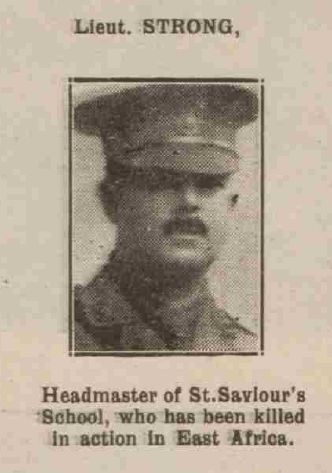 |
|
Sadly for George’s family, his death was not the last of the
bad news. Bath Chronicle & Weekly Gazette – 19 September 1918 Lower Weston Family’s Second Sacrifice Mr & Mrs W. Strong, of 7 Kennington Road, Lower Weston, have received the sad news from an officer that their youngest son, Corporal Arthur Wm. Strong R.F.A., has been shot at short range, probably by a German sniper, and about eighteen months ago their eldest son, Lieut. G.H. Strong, headmaster of St. Saviour’s School, was killed in East Africa. They are now numbered among the ever-growing list of parents who have lost more than one son in the war. Deceased, who would have reached his 22nd birthday on the 24th inst., had been in the Army four years, joining up shortly after the outbreak of hostilities. He was in the Dardanelles campaign and when the peninsula was evacuated he went to France, where he was wounded, and came home early in the present year. He went out again last April and news of his death was received in the latter part of last week. In letters to the parents the deceased was described by an officer as the pride of their troop and it was remarked that “a braver and more intelligent boy never wore uniform”. He was attached to the Headquarters Staff and was highly esteemed by officers and comrades alike. He was educated at Bathforum and the Technical School and was for some time on the staff of the “Bath & Wilts Chronicle”. He was a very promising youth, but did not care much for newspaper work, and was eventually articled to Isaac Pitman & Sons. He was a member of the Territorial Force and, being very keen on soldiering, lost no time in responding to his country’s call for more men. Sergeant-Major Edgar Strong is in France in the R.A.M.C. |
Burial | ||
| Lieutenant George
Strong is buried at Dar-es-Salaam (Upanga Road) Cemetery, Tanzania.
The cemetery was opened as a war cemetery in March 1918 when
the European section of Ocean Road Cemetery was closed. After the Armistice,
Commonwealth and German graves were brought into this site from Kidete, Lansi
and Utete Cemeteries. The cemetery now contains 231 Commonwealth burials of the
First World War (Source: CWGC). | ||
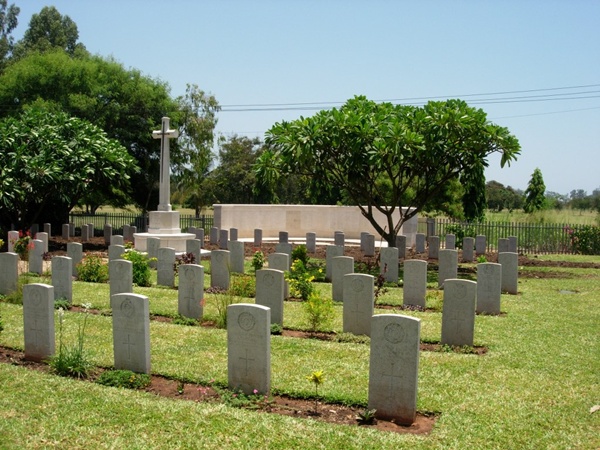 | ||
|
Upanga Road Cemetery in Dar-es-Salaam, where George Strong is buried. [Image: www.nzwargraves.org.nz] |
Decoration | ||
|
Lieutenant George Strong would have been posthumously awarded the British
War Medal and the Allied Victory Medal. | ||
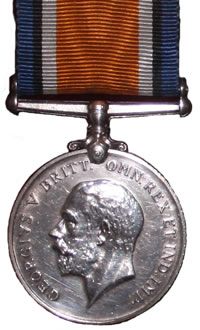 | 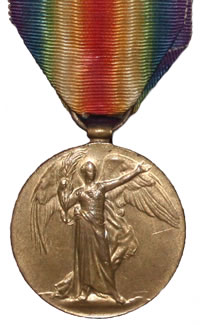 | ||
| British War Medal 1914-18 | Allied Victory Medal |
Commemoration | ||
 In addition to his commemoration on the South Twerton School memorial, George Strong is commemorated as follows: | ||
|
Bath War Memorial See separate page for details of the Bath War Memorial. George Strong's inscription: |
 |
|
Larkhall (St. Saviour's Parish) Memorial The Larkhall war memorial is situated within the grounds of St Saviour’s church and bears the names of both George Strong and his brother Arthur. The newspaper report of the dedication of this memorial made special mention of George Strong. |
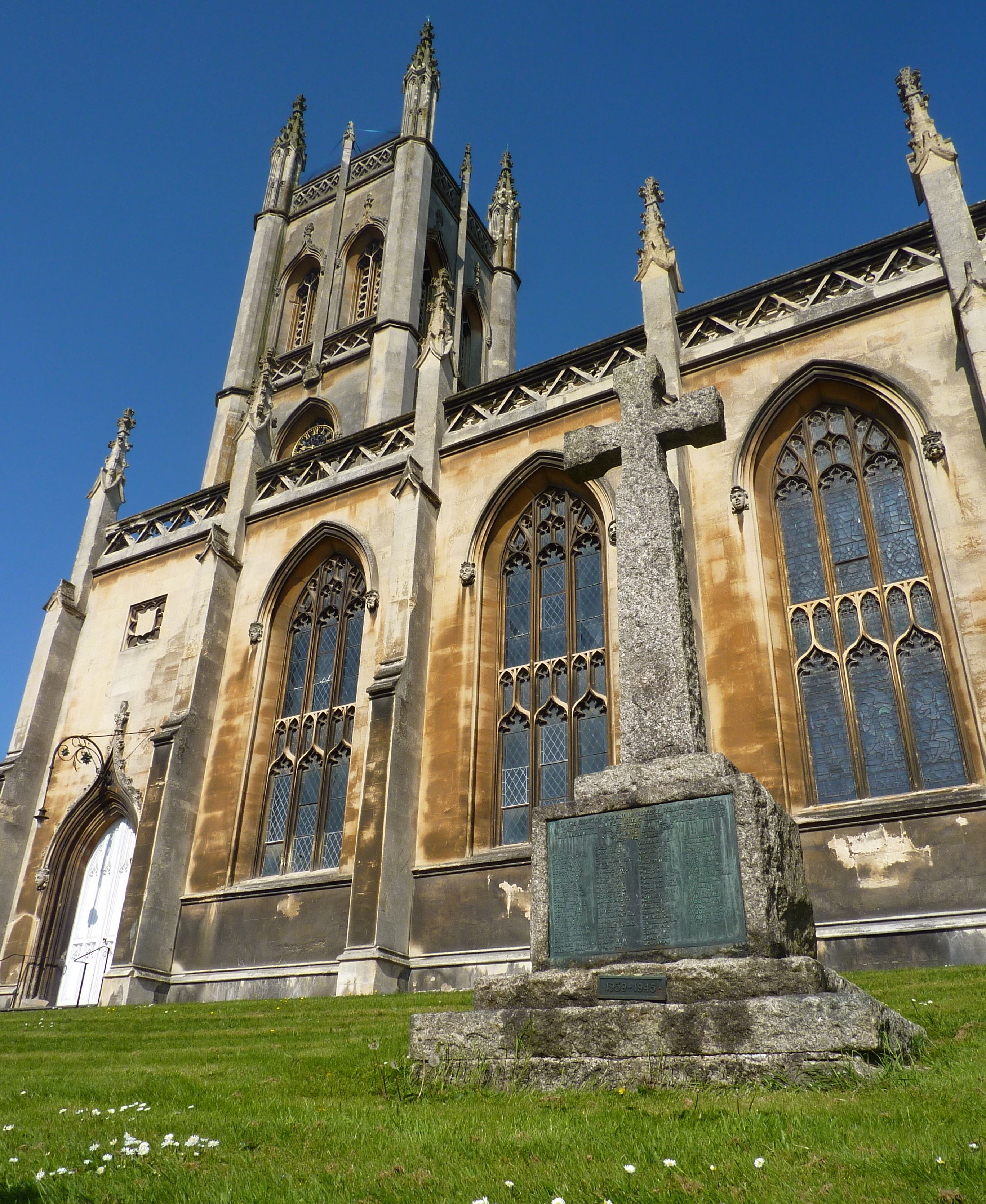 |
| The inscriptions for brothers George and Arthur Strong among the names of the fallen soldiers of Larkhall: |
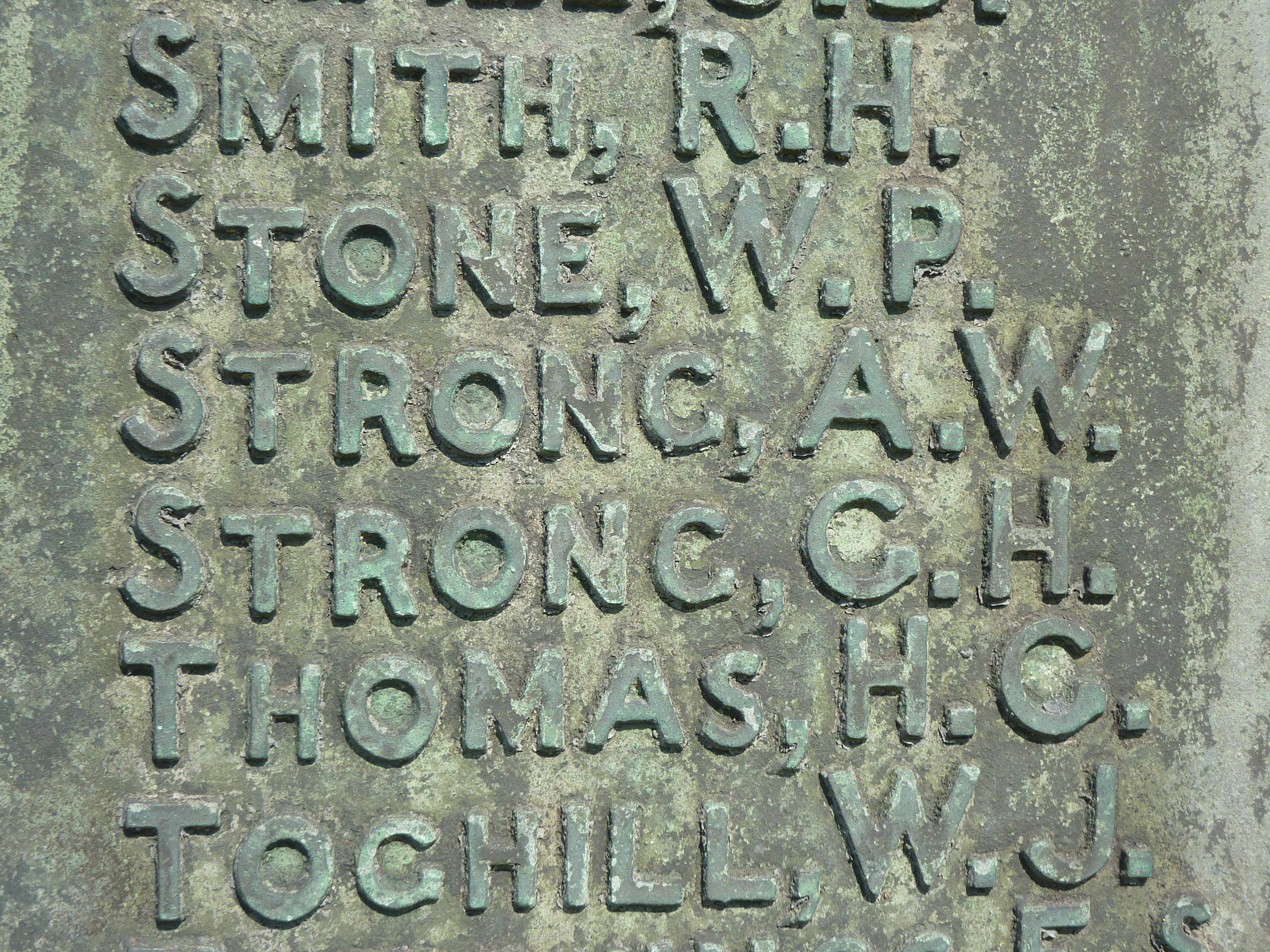 |
|
St Saviour's School Memorial The school where George Strong
was Headmaster has its own
memorial to its fallen soldiers. The current Head of the school was
kind enough to allow access to view and photograph this beautiful
memorial. |
 | ||
|
The St Saviour’s School Memorial and the inscription for George Strong at the head of the list |
|
The memorial includes a locked compartment at the bottom of
the memorial. Mr O’Shea, the Headmaster of St Saviour’s who showed the memorial, relates that
this compartment contained scrolls with the names of all the former pupils who served in
WW1 (including survivors) and a separate list of all those who contributed to
the public subscription for the creation and erection of the memorial. The text on the lockable section is: “Went
the day well? We died and never knew But well or ill, England, we
died for you.” This is a slight – perhaps deliberate – misquote from an
original epitaph written by John Maxwell Edmonds in 1918. The Edmonds original
reads … “Freedom, we died for you”. |
|
St Saviour's Memorial Tree George Strong is also commemorated, along with the scholars of St Saviour's School, by a tree planted in Larkhall in 1919. An article in the Bath Chronicle in November 2014 drew our attention to this and we found the following article in the 1919 newspaper (Bath Chronicle & Weekly Gazette, 15th November 1919): A TREE OF REMEMBRANCE MEMORIAL TO OLD BOYS OF ST. SAVIOUR'S SCHOOL As
a memorial to the boys of St. Saviour's School who laid down their
lives in the war, as also did the headmaster (Lieutenant George
Strong), an oak tree was planted at the Larkhall Recreation Ground on Tuesday
by twenty boys belonging to Standards VII. and ex-Vll. at. the schools.
Scholars of both sexes, many carrying Union Jacks, assembled at
the ground shortly before half-past two and formed a circle round
the hole which had been dug for the roots of the tree. The Rector of
St. Saviour's (the Rev. A. Wilkinson Markby) offered the opening
prayers of thanks for deliverance and for the future, which were
followed by the singing of 'O God, our help.' The Rector said their object was to try perpetuate in a visible way the memory of some of their brave lads who had laid down their lives for their country. The oak tree they saw before them was to be planted as an outward and visible sign of the memory which they wanted to hold dear of those brave men who had given their all for them to preserve their homes and their land, and also to mark their thanksgiving to Almighty God for restoring peace. Among the schools he did not think there had been a more loyal school in Bath than St.Saviour's. They had contributed by thought, by prayer, and gifts to help their country, and no fewer than 50 had laid down their lives. St. Saviour's also stood at the top the list for war savings with £850 , and he was told that 34 more certificates were purchased during the past year up to September than in any other elementary school in the city. They prayed that the tree they were about to plant might live long and flourish and speak to the generations to come of the strength which the oak always spoke to them, and of the strength of the men of the country who fought and laid down their lives. THE IMPORTANCE OF FORESTRY. Lieutenant-Colonel
H. P. P. Leigh, C.I.E., also gave a brief address, in which he
emphasised the importance of tree planting for the country. Every
country ought to be self-supporting, and among the things required to
make it so was timber. Had they in the war had enough timber at home
they would have saved hundreds millions of pounds. He was glad that the
Government had at last seen the necessity for going in for forestry,
and believed there was a big scheme in hand which would in time bear
fruit. Colonel Leigh explained the effect trees had on rainfall, and
cited instances of what, to his own knowledge, occurred in India, where
the planting trees had doubled the rainfall in 30 years. The Rector mentioned that there would be a barricade round the tree, and a board, on which would be painted "This tree, of remembrance to our glorious dead and of thanksgiving for peace, was planted by the scholars St. Saviour's School on the eleventh day of the eleventh month, 1919, this being the first anniversary of Armistice Day." "England" was then sung by the scholars, after which the planting of the tree was proceeded with, this operation being superintended by Mr. T. Riddle (superintendent of the pleasure grounds), who had the assistance of two workmen. The Rector, Colonel Leigh, Mr. G. J. Jolliffe, and Mr. F. J. Gallaway (headmaster) all shovelled earth on to the roots, after which the planting was completed by the following boys: G. Cryer, E. Seal, C. Read, S. Lane, B. Ponsford, R. Banks, R. Wright, N. Ling, J. Wharton, G. Ball, S. J. Lane, L. Brooks, R. Swift, F. Hazell, J. Sage, W. Haskell, W. Ford, C. Bartlett, G. and F. Durman. Kipling's "Recessional" was then sung, and was followed by the depositing at the foot of the tree laurel wreaths. Then came the roll of the drum and the kettle drums by Mr. F. J. Garraway and S. J. Lane and R. Lake, the "Last Post" by Mr. James Walters, then the National Anthem, and rounds of cheers, among those thus honoured being the lads of the school who had made the supreme sacrifice in the war. Alderman Bush and Major-General Bradshaw were unavoidably absent. |
|
"Went the Day Well?": St Saviour's School Production 2017 George Strong was
commemorated, along with the other named servicemen on the St Saviour's
School memorial, by a superb production put on by the school in
July 2017. The drama featured narrative part-written by the Year 6
schoolchildren and relating to the individual servicemen. There was
also evocative original music and visual artwork to bring the scenes to
life. The children and the school really excelled themselves, with some
great support funded from the Heritage Lottery Fund. The production was
given at the school and at the Egg Theatre.
Apart from some great acting, a highlight was the train-ride through
Africa, illustrated by the children's art (brought to life in
animation) and accompanied by African-style music. The thunderous
tumult of the battlefield was also powerfully rendered. 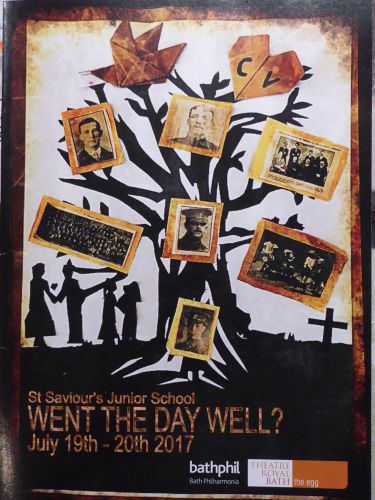 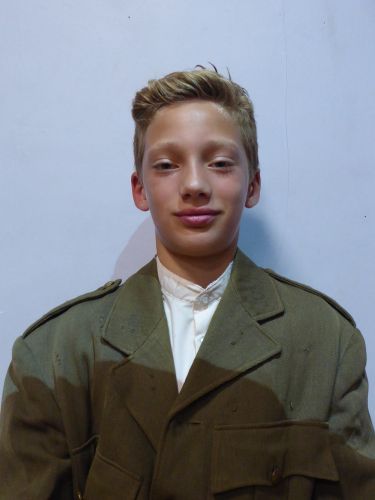 (L) The program for school production "Went The Day Well?" |
Further Information |
The Strong family beyond the war
George Strong’s father died in 1926 aged 78. His mother died
in 1944: Bath Weekly Chronicle & Gazette – 2 December 1944 Former Bath Headmaster’s Mother The death occurred on Saturday of Mrs Mary A Strong, of 5, Brock
Street, Bath, in her 90th year. She was the mother of Mr. George Strong, who was the Headmaster of St.
Saviour’s School, Larkhall, Bath, for some years and who was killed with his
brother Arthur during the last war. Mr Arthur Strong was at one time a member
of the editorial staff of the “Chronicle”. Mrs Strong is survived by one son. George’s brother Edgar
survived the war, but Directories do not show him listed in Bath after the war,
so we must assume he settled elsewhere. Research shows a potential death in
1975 of an Edgar Strong in North Yorkshire that may be salient. |
Living RelativesIt would be great to hear from any other living relatives of George Strong, which would necessarily be through any descendants of brother Edgar Strong. Please get in touch!If you have any further information on George Strong or want to suggest corrections / improvements for this page, please use the Contact page to get in touch. |